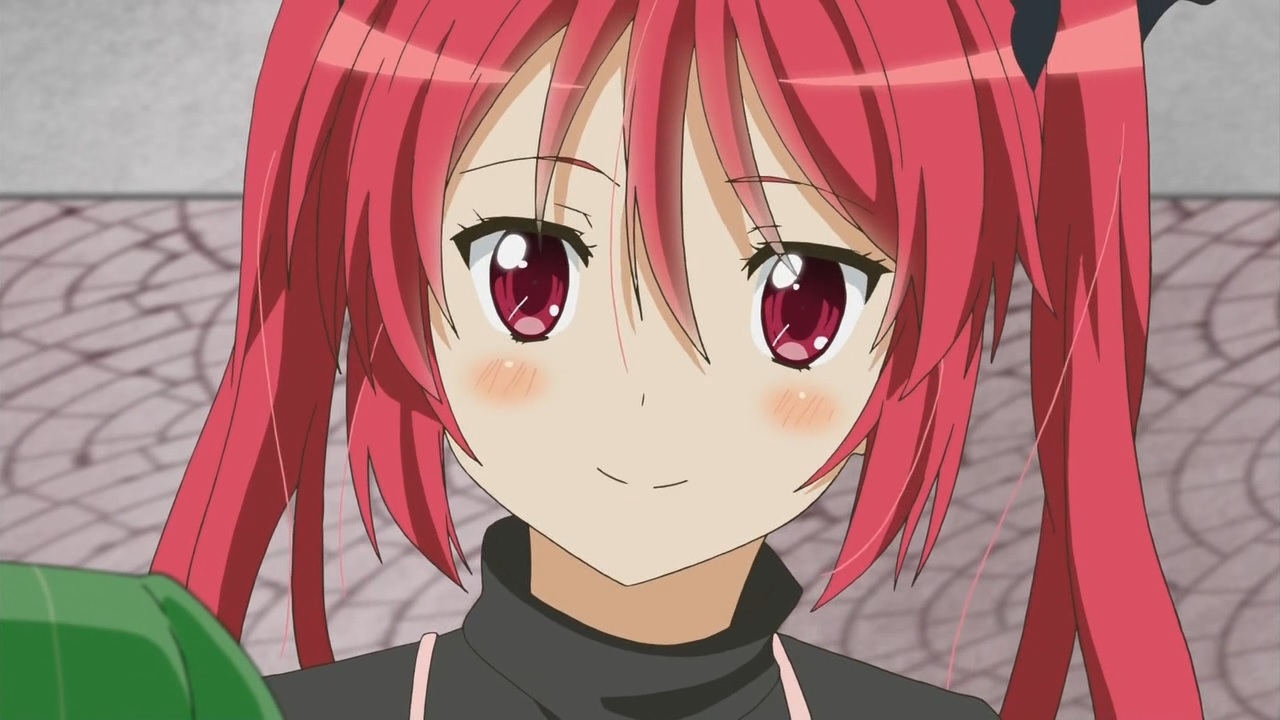Haiyore! Nyaruko-san W Episode 6 References
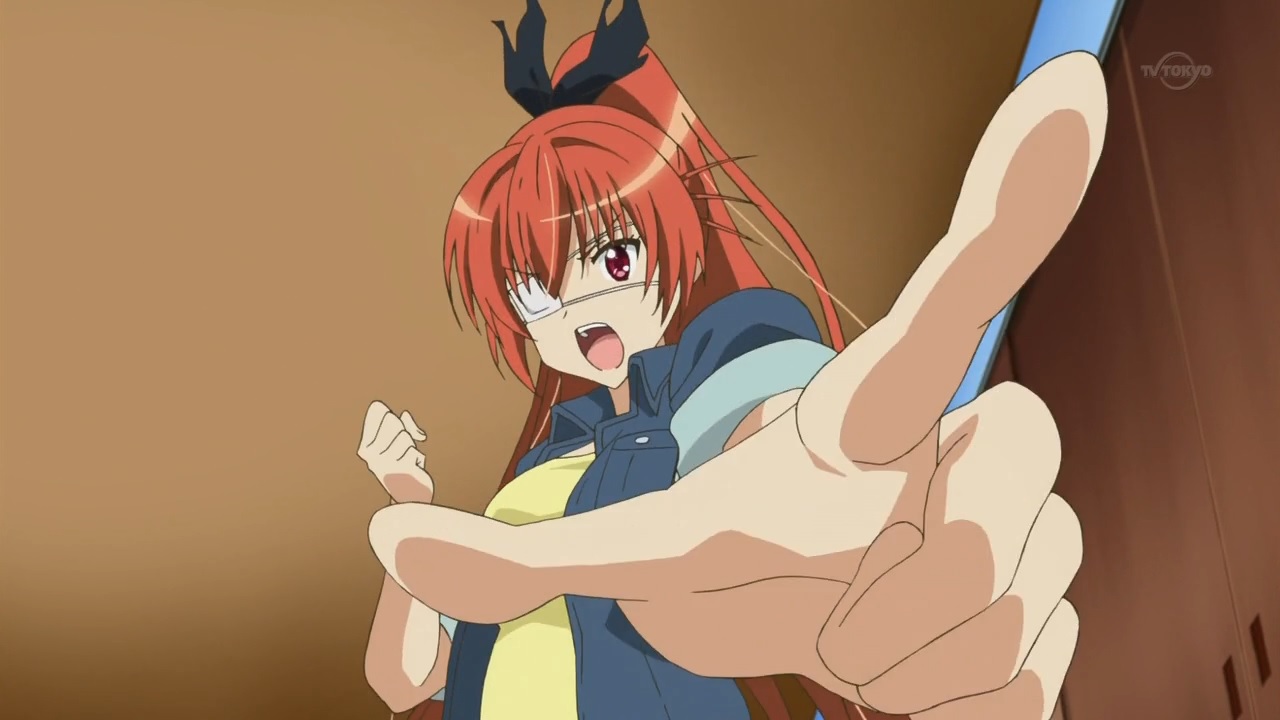
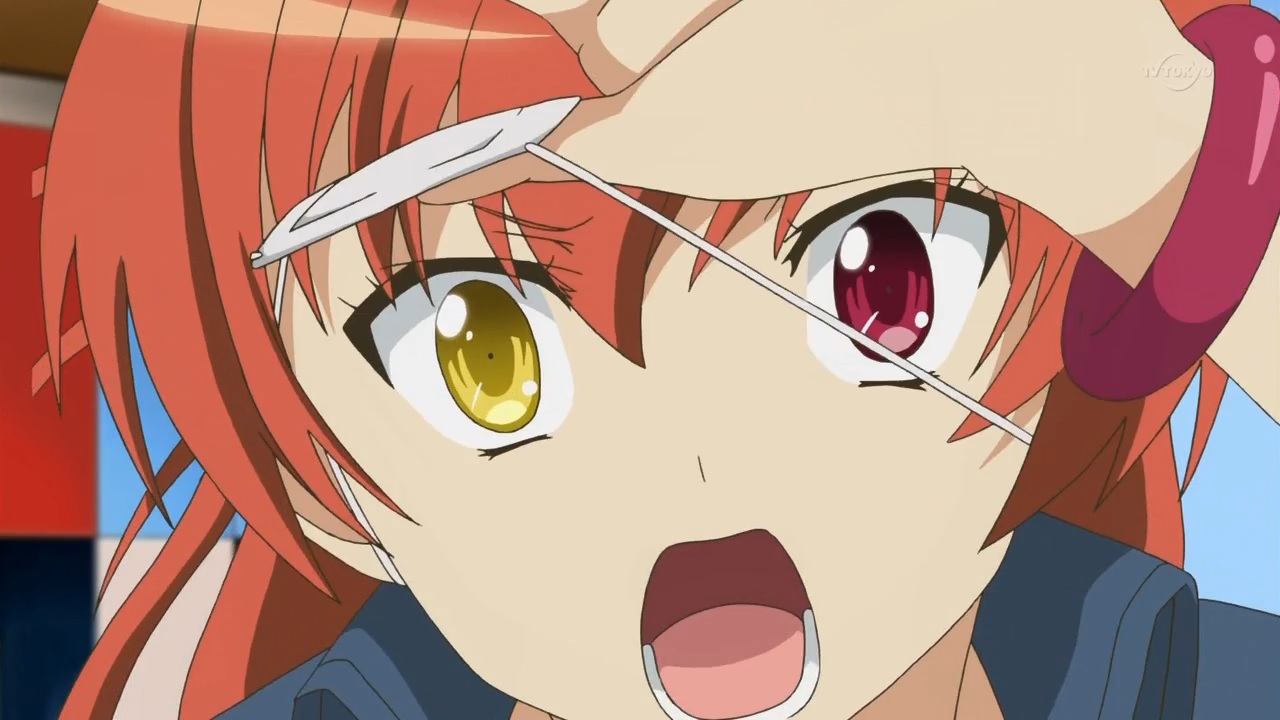
"Fulfilled real life, split apart! Synapse, burst open!" (0:26)
The Japanese line is "Hazero riajuu! Hajikero shinapusu!" (爆ぜろリア充!弾けろシナプス!). This is referencing a line said by Takanashi Rikka (小鳥遊六花) in "Chuunibyou demo Koi ga Shitai!" (中二病でも恋がしたい!), "Regardless of Chuunibyou, I Want to Fall in Love!", a light novel series written by Torako (虎虎) and published in 2011. The series was later adapted into an anime series in 2012. Rikka's line goes, "Hazero riaru! Hajikero shinapusu!" (爆ぜろリアル!弾けろシナプス!), which translates to "Reality, split apart! Synapse, burst open!". In addition, Cthune is wearing an eye patch over her right eye, and she is wearing a yellow contact lens on her right eye. In the series, Rikka wears an eye patch over her right eye and also wears a yellow contact lens on her right eye. Images for reference:
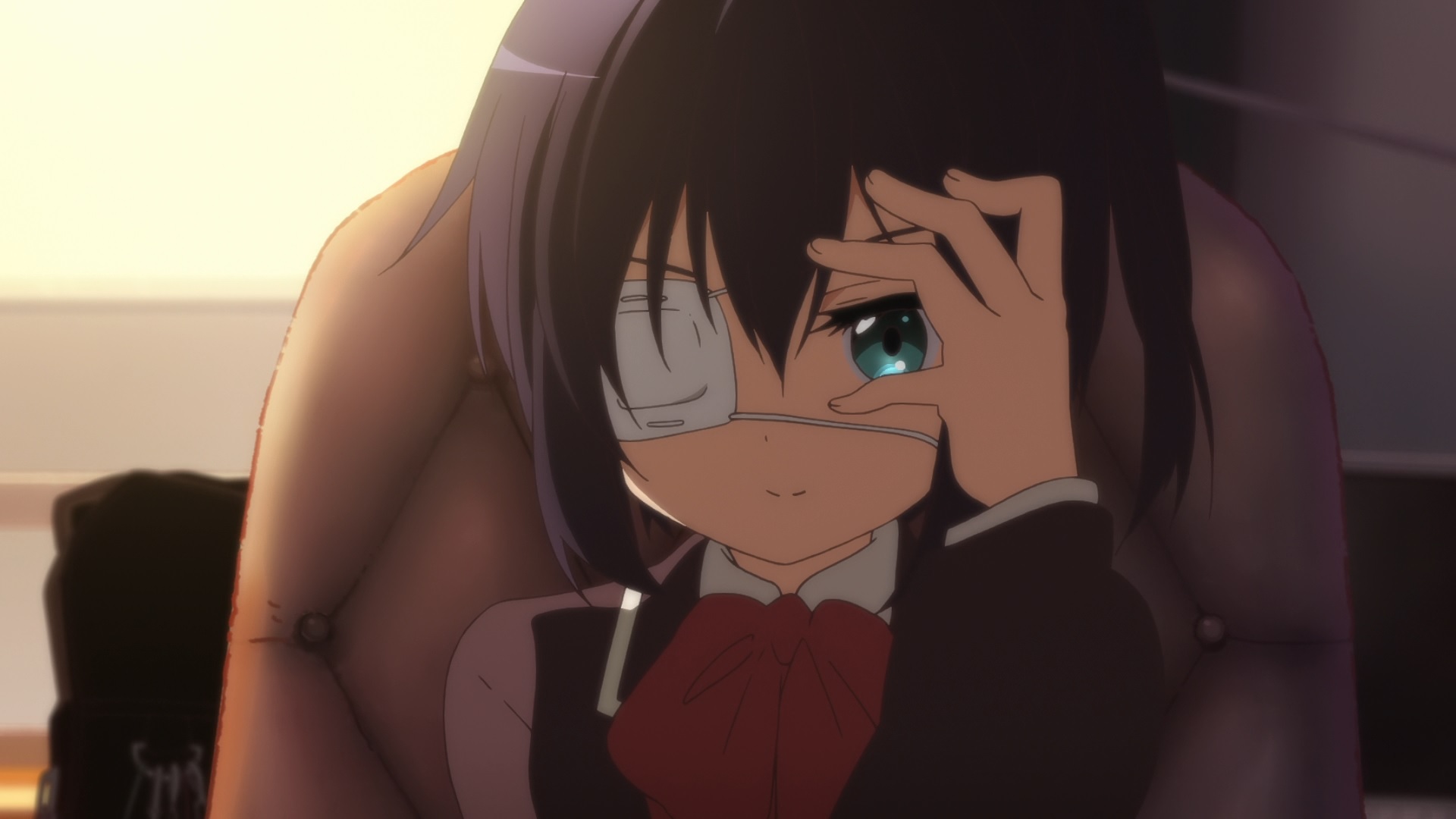

Furthermore, a magic circle appears over Cthune's right eye.
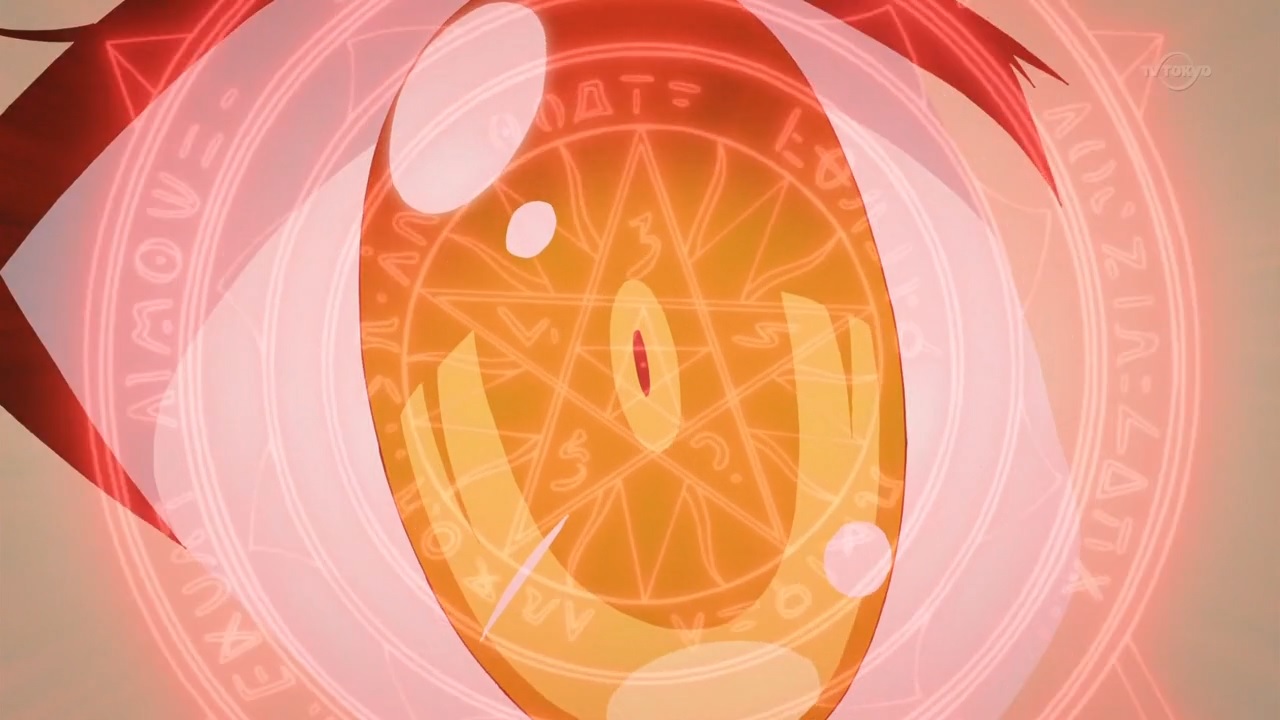
This is also referencing Rikka. She believes that she has supernatural powers and that her powers are unleashed when she removes her eye patch. In a depiction of what she believes happens when she removes her eye patch, a magic circle appears over her right eye. Image for reference:
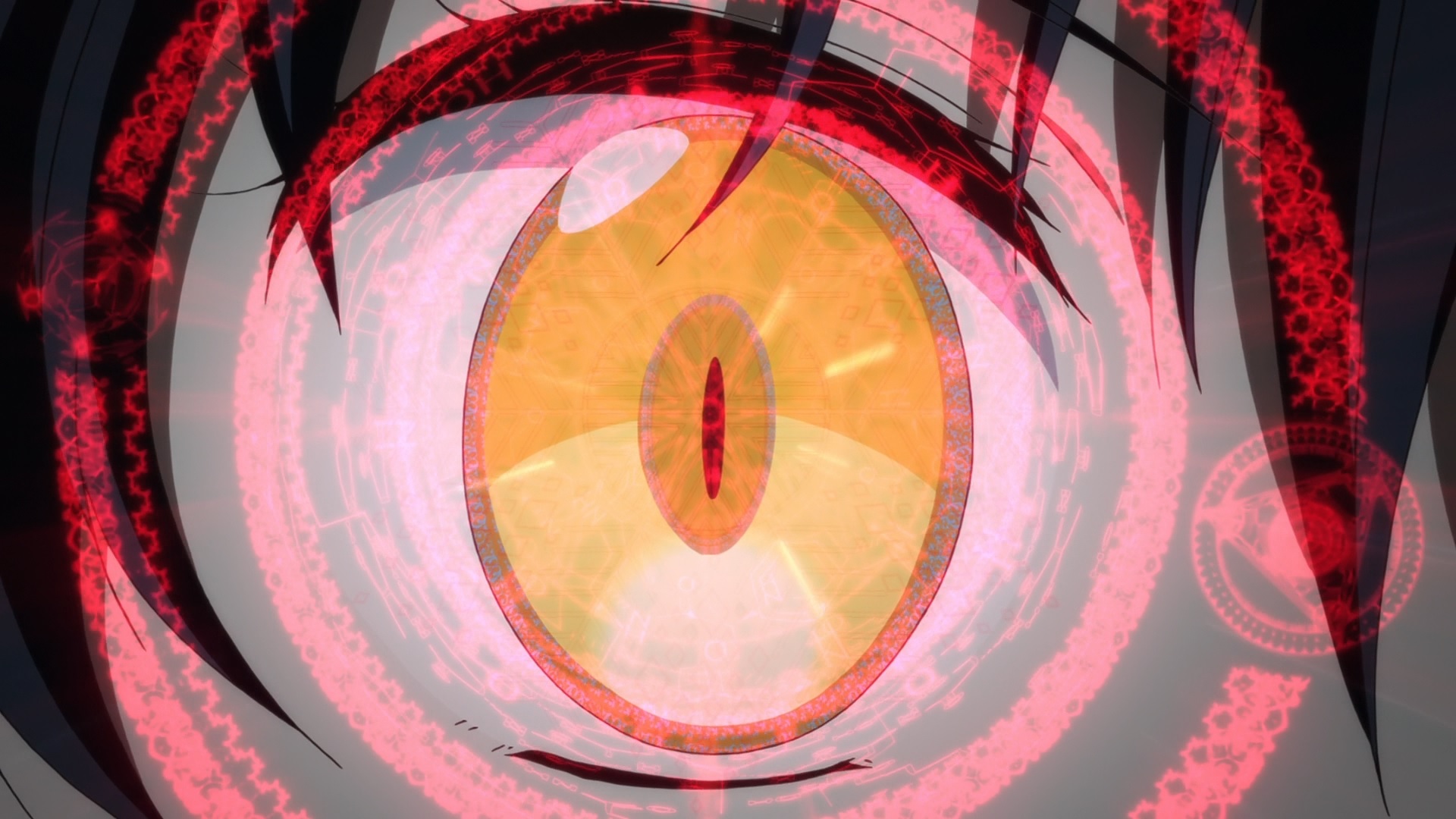
On a related note, specifically, Cthune says "riajuu" (リア充), which is a term that combines "riaru" (リアル), which means "real" or "reality", and "juujitsu" (充実), which means "fullness" or "completion". As a whole, "riajuu" (リア充) is a slang term that refers to a person who is satisfied with his or her real (offline) life.
(0:34)
The line at this time goes as follows:
「全然関係ありませんが、怨念で人を殺せたらいいですよね。」This is referencing a line said by Yokoshima Tadao (横島忠夫) in volume 13 of "Ghost Sweeper Mikami: The Great Paradise Battle!! " (GS美神 極楽大作戦!!), a manga series written by Shiina Takashi (椎名高志) and published from 1991 to 1999.S2 His original line is, "Nikushimi de hito ga korosetara......!!" (憎しみで人が殺せたら・・・・・・!!), which translates to "If it were possible to kill someone with hatred......!!". Image for reference:
"Zenzen kankei arimasen ga, onnen de hito wo korosetara ii desu yo ne."
"This is completely unrelated, but it'd be great if it were possible to kill someone with a grudge."
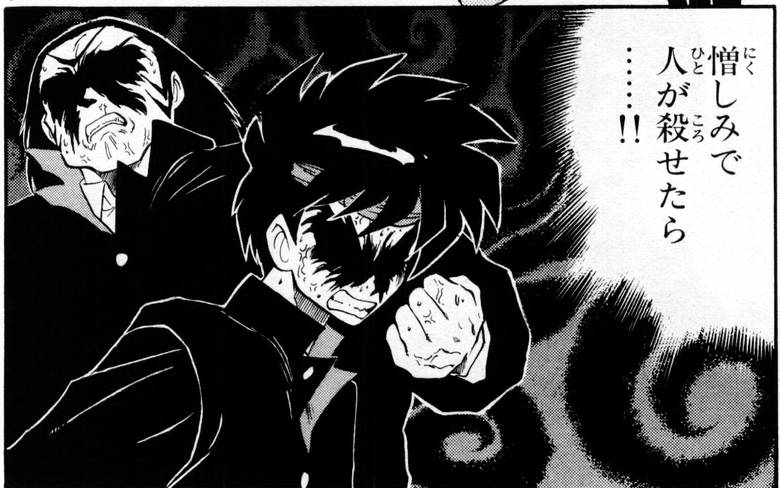
"The boy is always my darling" (1:18)
The Japanese line is "Shounen ha itsudatte mai daarin" (少年はいつだってマイダーリン). This is referencing "Urusei Yatsura Istudatte Mai Daarin" (うる星やつら いつだってマイ・ダーリン), "Urusei Yatsura: Always My Darling", an anime movie released in 1991.S1
"If you two are a couple, then you two should be able to communicate affectionate nuances by looking each other in the eyes, right?" (1:30)
The Japanese line is "Koibito doushi dattara, me to me de tsuujiau iroppoi nyuansu toka, aru ja nai?" (恋人同士だったら、目と目で通じ合う色っぽいニュアンスとか、あるじゃない?). This is referencing a line in the lyrics to "MUGO n Iroppoi" (MUGO・ん…色っぽい), "Silently... Affectionate", a song sung by Kudou Shizuka (工藤静香) and released in 1988.S2 The original line goes, "Me to me de tsuuji au, kasuka ni n iroppoi" (目と目で通じ合う かすかに ん 色っぽい), which translates to "Communicating by looking each other in the eyes, faintly affectionate".

(3:37)
The line at this time goes as follows:
「私とのもじもじとデートとか、夢見た未来みんな見たいとか!」This is referencing lines in the lyrics to "Futari no Mojipittan" (ふたりのもじぴったん), "A pair of Mojipittan". This song is the theme song of "Kotoba no Pazuru Mojipittan (ことばのパズル もじぴったん), "Word Puzzle Mojipittan", a video game released in 2001. The original lines go as follows:
"Watashi to no mojimoji to deeto to ka, yume mita mirai minna mitai to ka!"
"Like you have a shy date with me, or everyone wants to see the future you dreamed of!"
「ちょっと もじもじと でーと」
「ゆめ みた みらい みな みたい」
"Chotto mojimoji to deeto"
"Yume mita mirai mina mitai"
"A bit of a shy date"
"Everyone wants to see the future you dreamed of"
"Anyway, 1,000 falsehoods, 10,000 lies!" (3:47)
The Japanese line is "Douse sen no itsuwari, man no uso desu!" (どうせ千の偽り、万の嘘です!). This is referencing a line said by Uratarosu (ウラタロス) in episode 5 of "Kamen Rider Den-O" (仮面ライダー電王), a Japanese TV show about a masked super hero that aired from 2007 to 2008.S2 His line goes, "Kotoba no ura ni ha hari senbon. Sen no itsuwari, man no uso" (言葉の裏には針千本。千の偽り、万の嘘), which translates to "Behind each word are 1,000 hooks. 1,000 falsehoods, 10,000 lies".
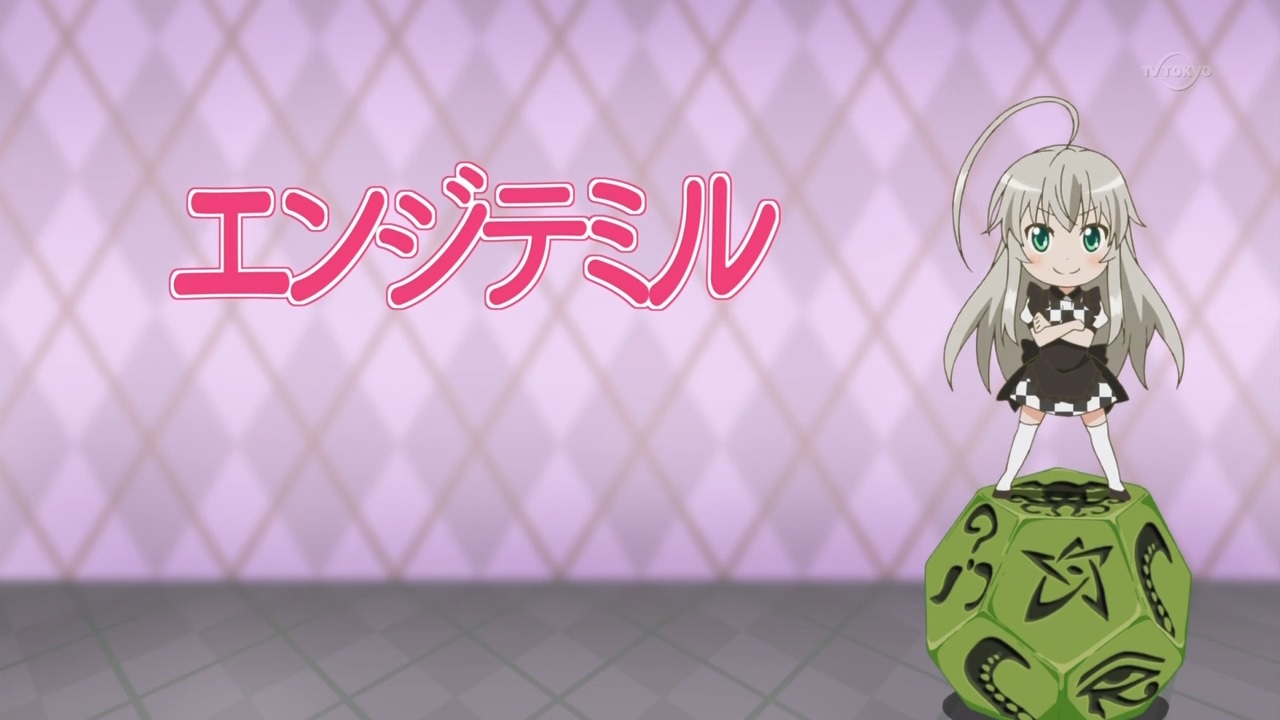
(4:18)
The title of this episode is "Enjite Miru" (エンジテミル), which roughly translates to "Try to Act". This is referencing "Inshite Miru" (インシテミル), "Try to be Immersed", a mystery novel written by Yonezawa Honobu (米澤穂信) and published in 2007.S1 The origin of the title of this novel is the term 「淫する」 (insuru), which in context means "to be immersed in". The meaning of the title is "Try to be immersed in the mystery".
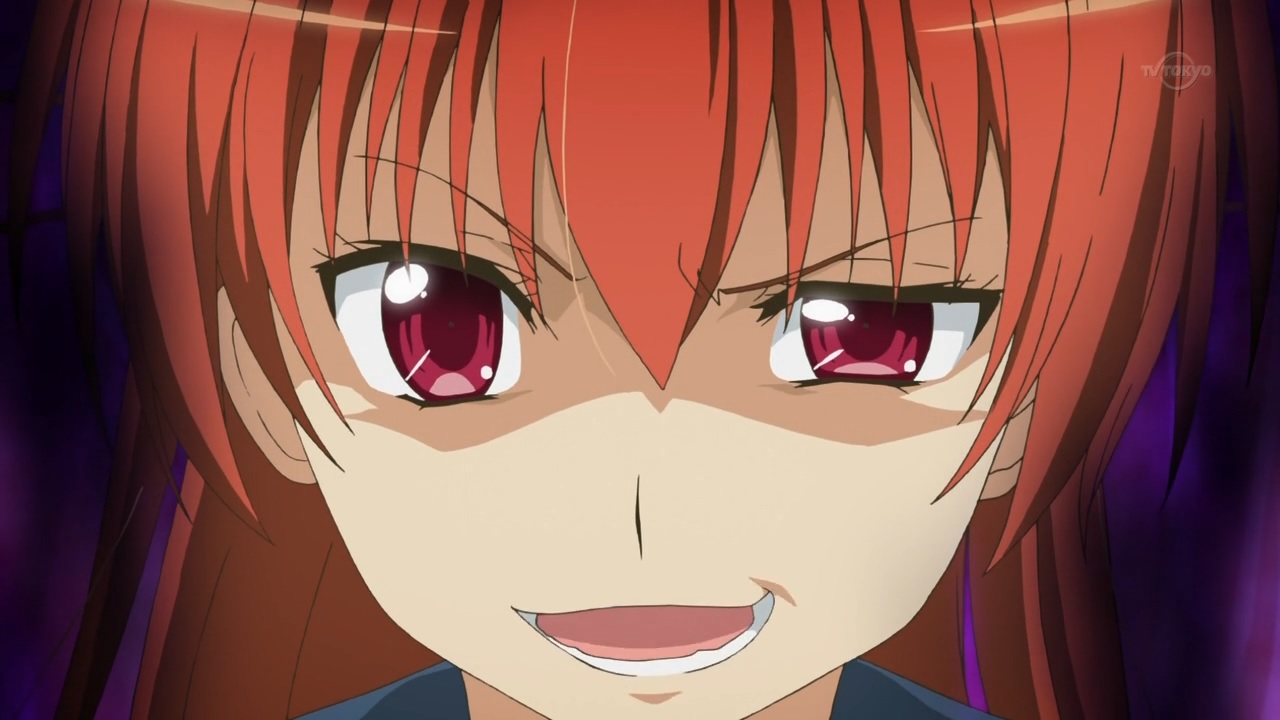
"As long as there's love, it doesn't matter right?" (5:09)
The Japanese line is "Ai sae areba kankei nai yo ne" (愛さえあれば関係ないよね). This is referencing "Onii-chan da kedo ai sae areba kankei nai yo ne" (お兄ちゃんだけど愛さえあれば関係ないよねっ), a light novel series written by Suzuki Daisuke (鈴木大輔) and published starting from 2010. The title translates to "He's my older brother, but as long as there's love that doesn't matter, right?". On a related note, an anime adaptation of this series aired in 2012, and in this adaptation one of the main characters, Nikaidou Arashi (二階堂嵐), is voiced by Kitamura Eri (喜多村英梨), Mahiro's voice actor.
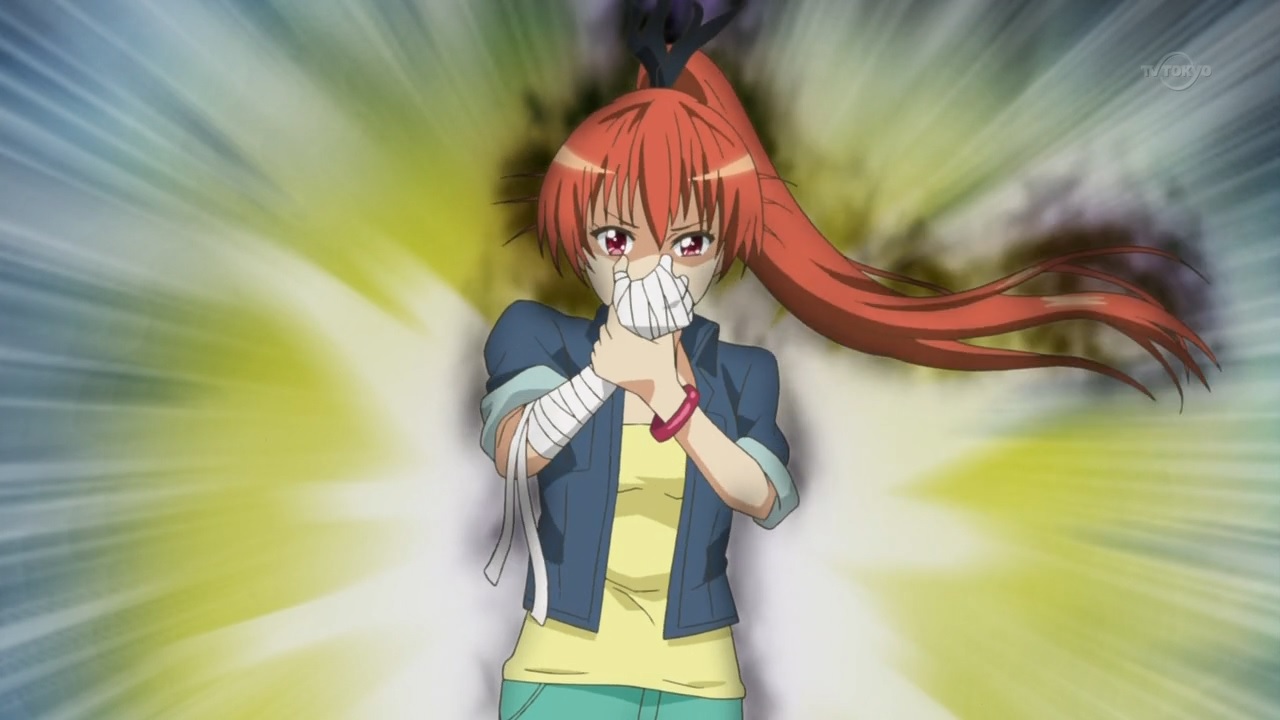
"I kill that illusion!" (5:12)
The Japanese line is "Sonna gensou ha, atashi ga buchikorosu!" (そんな幻想は私がぶち殺す!). This is referencing the catch phrase of Kamijou Touma (上条当麻) from "To Aru Majutsu no Indekkusu" (とある魔術の禁書目録), "A Certain Magical Index", a light novel series written by Kamachi Kazuma (鎌池和馬) and published from 2004 and is currently ongoing. His line, with variations, goes, "Sono gensou wo buchikorosu!" (その幻想をぶち殺す!), which has the same meaning as above. In addition, Cthune thrusts her right hand in front of her. This is also referencing Touma, who is able to negate supernatural phenomena by touching it with his right hand.
(5:32)
The lines at this time go as follows:
「あの人と腕を組んで、避暑地を散歩していた時にね」This is referencing lines in the lyrics to "Congratulations!", a song sung by GODDESS FAMILY CLUB and released in 1993.S2 This song is the ending theme song to "Aa Megami-sama" (ああっ女神さまっ), "Ah! My Goddess!", an anime series that was released from 1993 to 1994. GODDESS FAMILY CLUB is a group consisting of Inoue Kikuko (井上喜久子), Touma Yumi(冬馬由美), and Hisakawa Aya (久川綾), who voice Belldandy (ベルダンディー), Urd (ウルド), and Skuld (スクルド) respectively in the series. On a related note, the voice actor who voices Skuld, Hisakawa Aya, also voices Yoriko. The original lines go as follows:
「偶然通りかかった教会で結婚式をやっていたの」
「私たちにも幸せを分けてほしいなって覗いてみたんだけど」
「幸せそうな二人を見てたら、なんだか急に涙が出てきちゃって」
「あの人のシャツで拭いたりしてね」
"Ano hito to ude wo kunde, hishochi wo sanpo shiteita toki ni ne"
"Guuzen toori kakatta kyoukai de kekkonshiki wo yatteita no"
"Watashi tachi ni mo shiawase wo wakete hoshii na tte nozoite mita n dakedo"
"Shiawase sou na futari wo mitetara, nandaka kyuu ni namida ga dete kichatte"
"Ano hito no shatsu de fuitari shite ne"
"While we were going for a walk with our arms linked at a summer resort"
"By chance we happened across a wedding being held at a chapel"
"It felt like they wanted to share their happiness with us too, so we took a look"
"After I saw the happy couple, suddenly the tears came out"
"I wiped my tears on his shirt"
「腕を組んだ 避暑地の散歩で」
「偶然出会う 教会(チャペル)のWedding」
「しあわせ わけてほしい」
「のぞいて いこうよ」
「しあわせそうなふたり」
「急に私 涙があふれて」
「あなたのシャツで拭いた」
"Ude wo kunda hishochi no sanpo de"
"Guuzen deau chaperu no wedding"
"Shiawase wakete hoshii"
"Nozoite ikou yo"
"Shiawase sou na futari"
"Kyuu ni watashi namida ga afurete"
"Anata no shatsu de fuita"
"While we were going for a walk with our arms linked at a summer resort"
"We happened across a wedding at a chapel"
"They want to share their happiness"
"Let's take a look"
"The couple looks so happy"
"Suddenly the tears come pouring out"
"I wiped my tears on your shirt"
"If only I had a notebook that could kill the person whose name I write in it." (5:58)
This is referencing "DEATH NOTE" (デスノート), a manga series written by Ooba Tsugumi (大場つぐみ) and published from 2003 to 2006. In the series, there is a notebook called the Death Note that causes the person whose name is written in it to die.
(6:27)
The line at this time goes as follows:
「ショコラ・ティラミス・エクレア・マロン・キャロット・グラッセ」This is referencing the names of characters that appear in "Bakuretsu Hantaa" (爆れつハンター), "Explosive Hunter", a manga series written by Akahori Satoru (あかほりさとる) and published from 1993 to 1998.S2 The characters are Chocolat Misu (ショコラ・ミス), Tira Misu (ティラ・ミス), Éclair Mocha (エクレア・モカ), Marron Glacé (マロン・グラッセ) and Carrot Glacé (キャロット・グラッセ).
"Shokora tiramisu ekurea maron kyarotto gurasse"
"Chocolat tiramisu éclair marron carrot glacé"
"The boy you're interested in is also normal, normal. Fairly normal, isn't he?" (6:56)
The Japanese line is "Ki ni naru shounen-kun mo futsuu, futsuu. Wari to futsuu nan ja nai no?" (気になる少年くんもふつう、ふつう。わりと普通なんじゃないの?). This is referencing lines in the lyrics to "Ki Ni Naru Ano Ko" (気になるあの娘), "That Girl You're Interested In", a song performed by Soutaisei Riron (相対性理論) and released in 2010.S2 The original lines go as follows:
「気になるあの娘の頭の中は」
「ふつう ふつう わりと普通」
"Ki ni naru ano ko no atama no naka ha"
"Futsuu futsuu wari to futsuu"
"That girl you're interested in, the inside of her head is"
"Normal, normal, fairly normal"
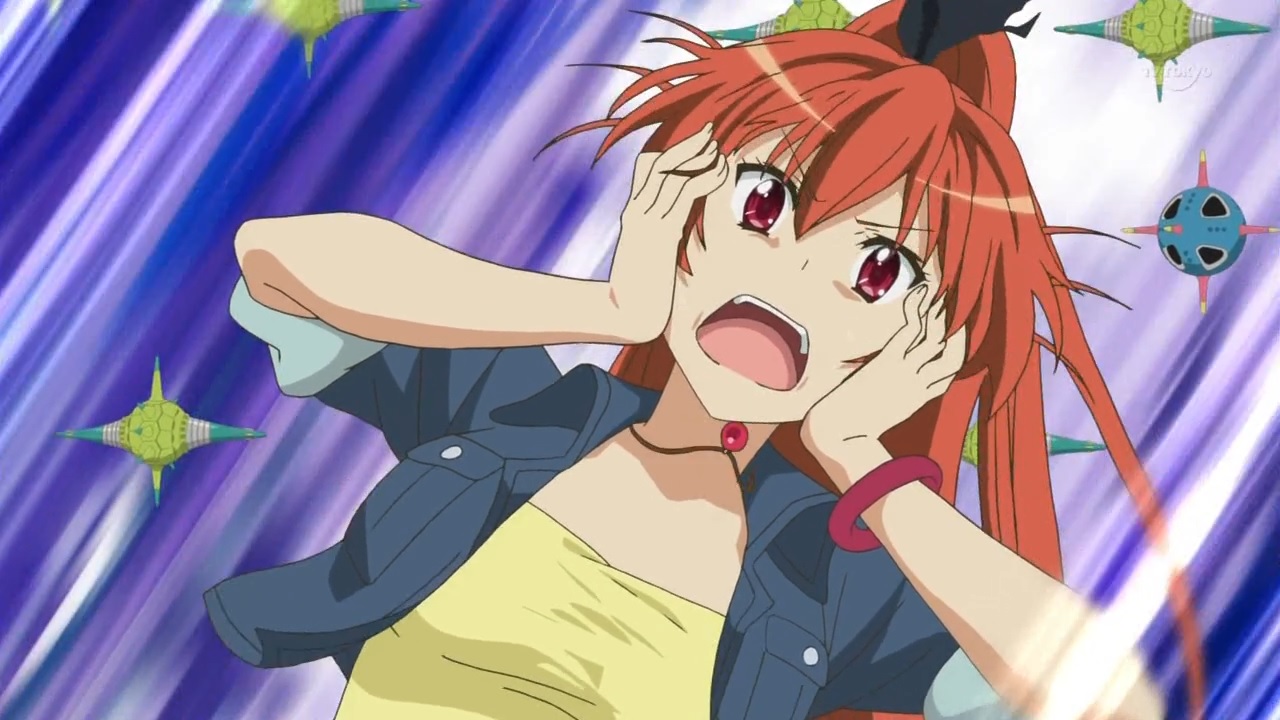
"Dislike?! In English, mine!" (7:14)
The Japanese line is "Kirai?! Eigo de iu to main!" (嫌い?!英語で言うとマイン!). The term 「嫌い」 (kirai) means "dislike" or "hate". This term has the same pronunciation as 「機雷」 (kirai), which means "mine" and refers to the explosive weapon. The mines that appear in the background are based on the Desler Mines (デスラー機雷) that appear in episode 11 of "Uchuu Senkan Yamato" (宇宙戦艦ヤマト), "Space Battleship Yamato", an anime series that aired from 1974 to 1975.S1 In the above scene, there are many green mines.

There is also a single blue mine.
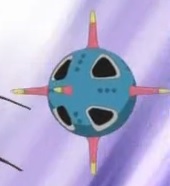
In episode 11 of "Uchuu Senkan Yamato", there is a minefield filled with many Desler Mines and a single control mine. The single blue mine is based on the Desler Mines.

The many green mines are based on the single control mine.
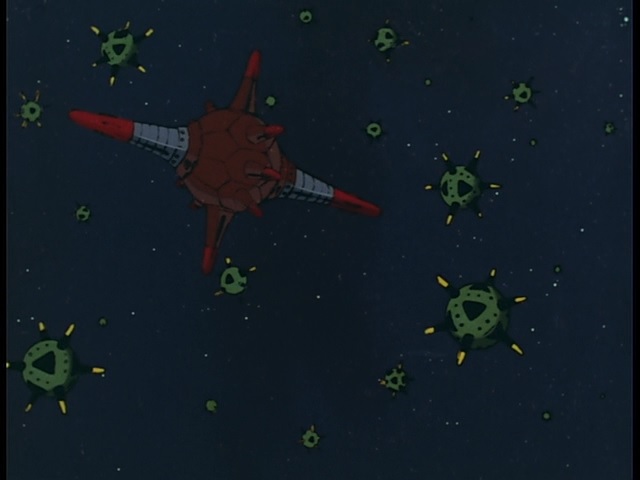
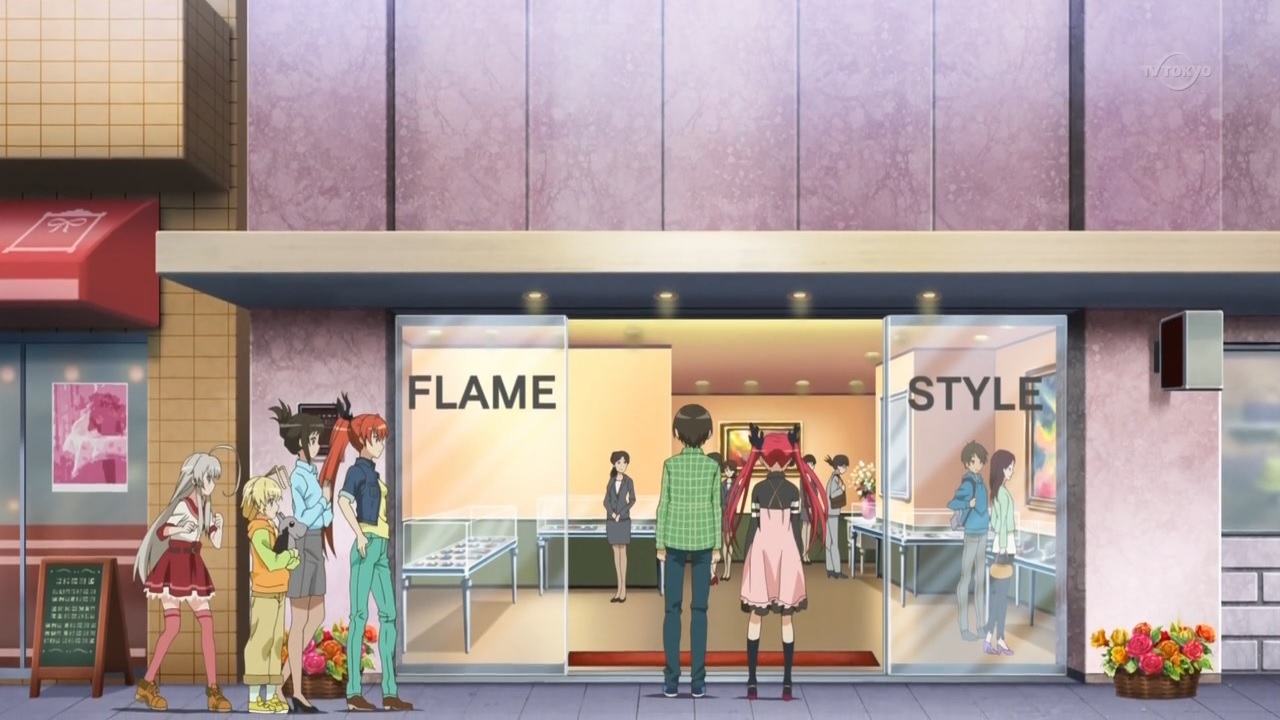
(8:01)
Cthuko and Mahiro go into a jewelry store called "FLAME STYLE". This is referencing the "Flame Style" (フレイムスタイル) form of Kamen Rider Wizard in "Kamen Rider Wizard" (仮面ライダーウィザード), a Japanese TV show about a masked super hero that aired from 2012 and is currently ongoing.

"Then the Ring of Eibon is a good choice." (8:14)
There are three references here:
* The symbol on the ring is based on the Sign of Eibon, a symbol from the Cthulhu Mythos. Image from the 5th edition rule book for the "Call of Cthulhu" RPG for reference:

In addition, Eibon is the name of a wizard in the Cthulhu Mythos. He appears in "The Door to Saturn", a short story written by Clark Ashton Smith and published in 1932.
* The appearance of the Ring of Eibon is based on the Wizard Rings used by Kamen Rider Wizard in "Kamen Rider Wizard" (仮面ライダーウィザード). Image for reference:
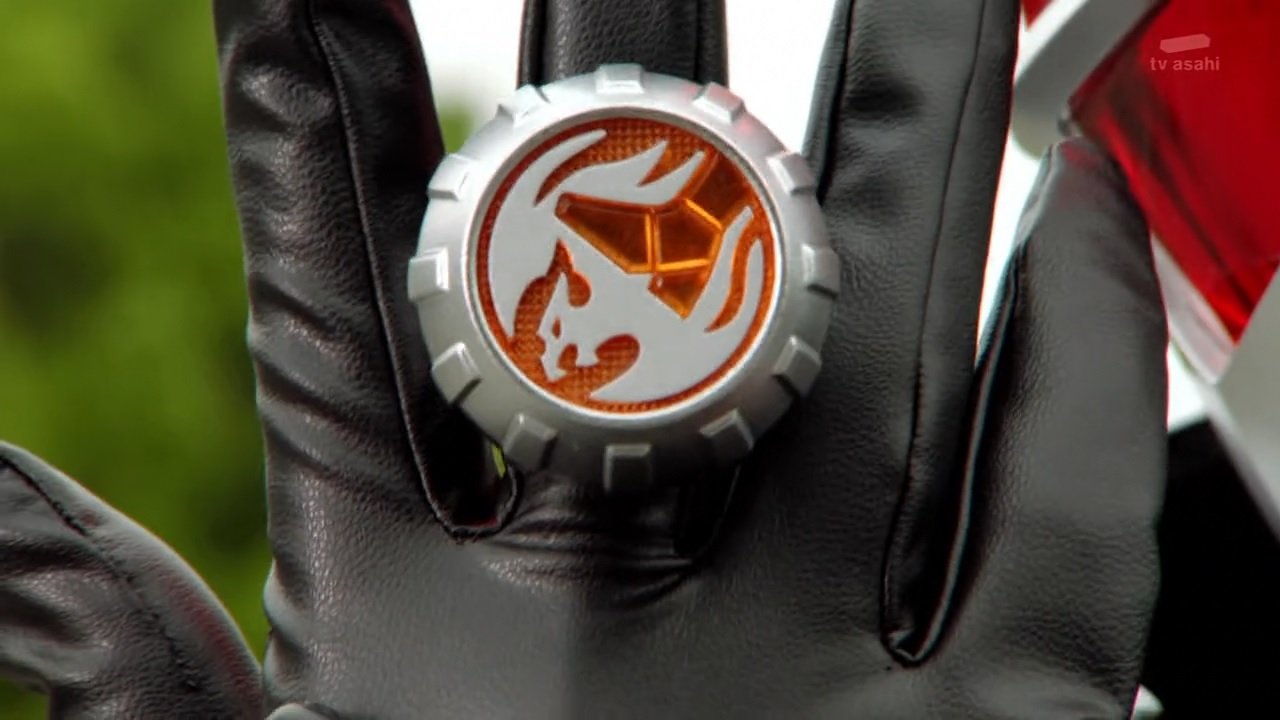
* "Eibon no Yubiwa" (エイボンの指輪), "Ring of Eibon", is a magical artifact in the Cthulhu Mythos. It appears in "The Beast of Averoigne", a short story written by Clark Ashton Smith and published in 1933. In the story, the ring is described as follows:
Then I bethought me of the ring of Eibon, which I had inherited from my fathers, who were also wizards. The ring had come down, it was said, from ancient Hyperborea; and it was made of a redder gold than any that the earth yields in latter cycles, and was set with a great purple gem, somber and smouldering, whose like is no longer to be found. And in the gem an antique demon was held captive, a spirit from pre-human worlds and ages, which would answer the interrogation of sorcerers.
"Incidentally, if you're not wearing the ring when you end a chapter, your sanity points will drop." (8:23)
There are two references here:
* This is referencing "VALKYRIE PROFILE" (ヴァルキリープロファイル), a video game released in 1999.S2 In the game, the main character, Valkyrie (ヴァルキリー), has a numerical parameter called "Fuuin Chi" (封印値), "Seal Value". In addition, there is an item called "Niiberungen no Yubiwa" (ニーベルンゲンの指環), "Nibelungen Ring". If Valkyrie does not have this ring equipped when the player ends a chapter, Valkyrie's Seal Value will decrease by 2 points.
* "SAN chi" (SAN値), "sanity points", is a parameter that characters have in the "Call of Cthulhu" role playing game. If a character's sanity points drop to zero, the character is permanently insane and normally can no longer be played.
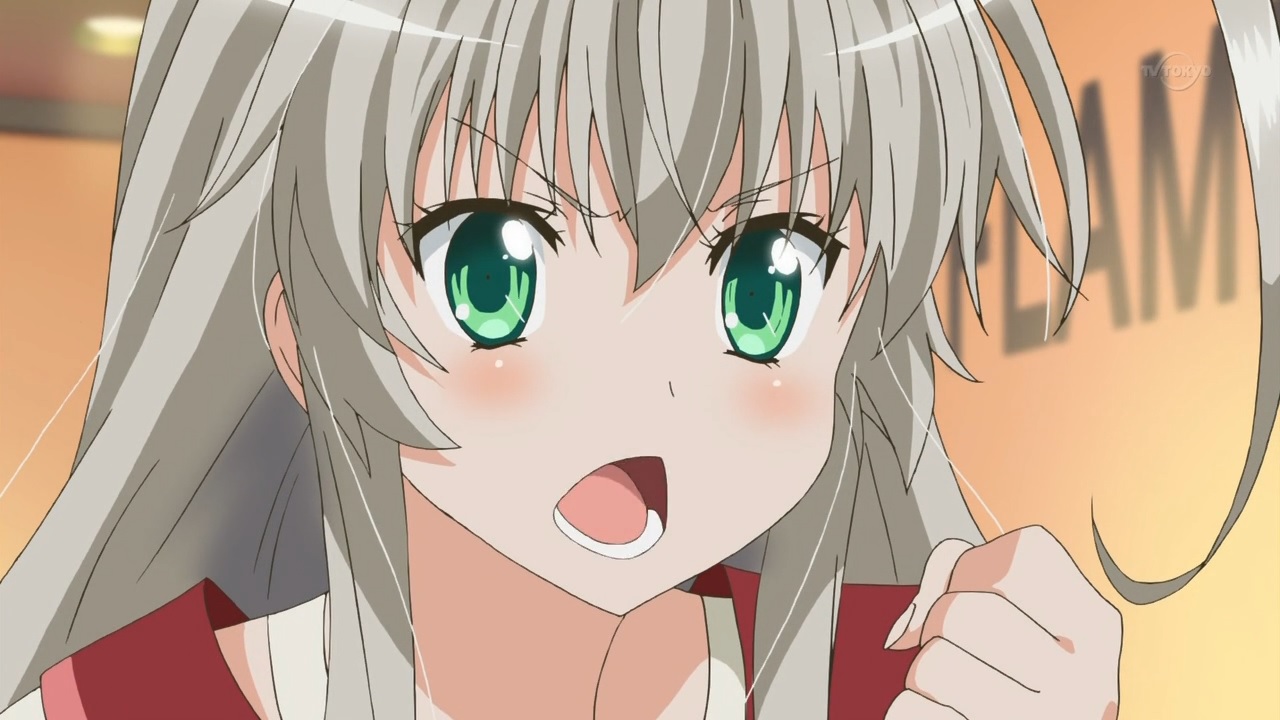
"Do you have anything like a ring that whittles away health when equipped just by walking?" (8:41)
This is referencing "Shi no Yubiwa" (しのゆびわ), "Ring of Death", from "Uizaadorii Kyouou no Shirenjou" (ウィザードリィ 狂王の試練場), "Wizardry: Proving Grounds of the Mad Overlord", a video game released in 1981.S2 A character equipped with the Ring of Death will lose 3 hit points per tile traversed.
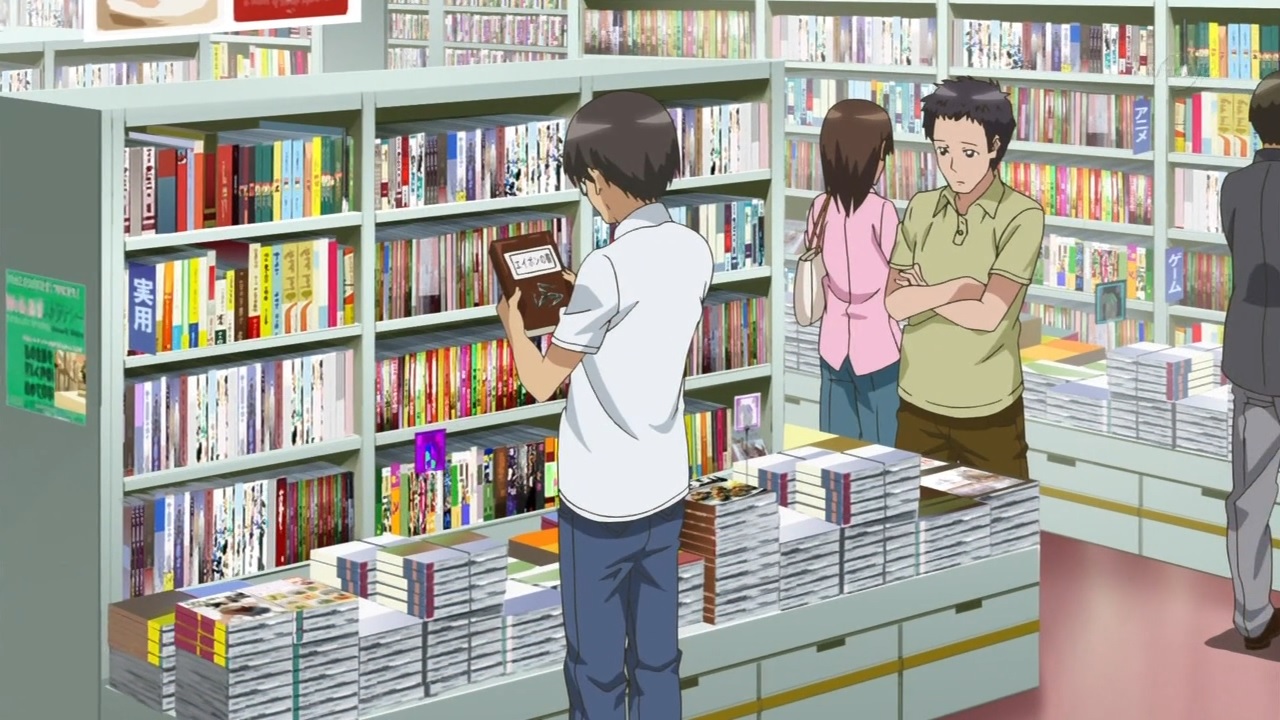
(8:49)
This is the book that the man is holding up.
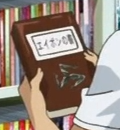
On the cover of the book is a symbol based on the Sign of Eibon. In addition, the title of the book is "Eibon no Sho" (エイボンの書), which translates to "Book of Eibon". This is referencing the Book of Eibon, a magical grimoire in the Cthulhu Mythos. It is mentioned in "The Beast of Averoigne", a short story written by Clark Ashton Smith and published in 1933.
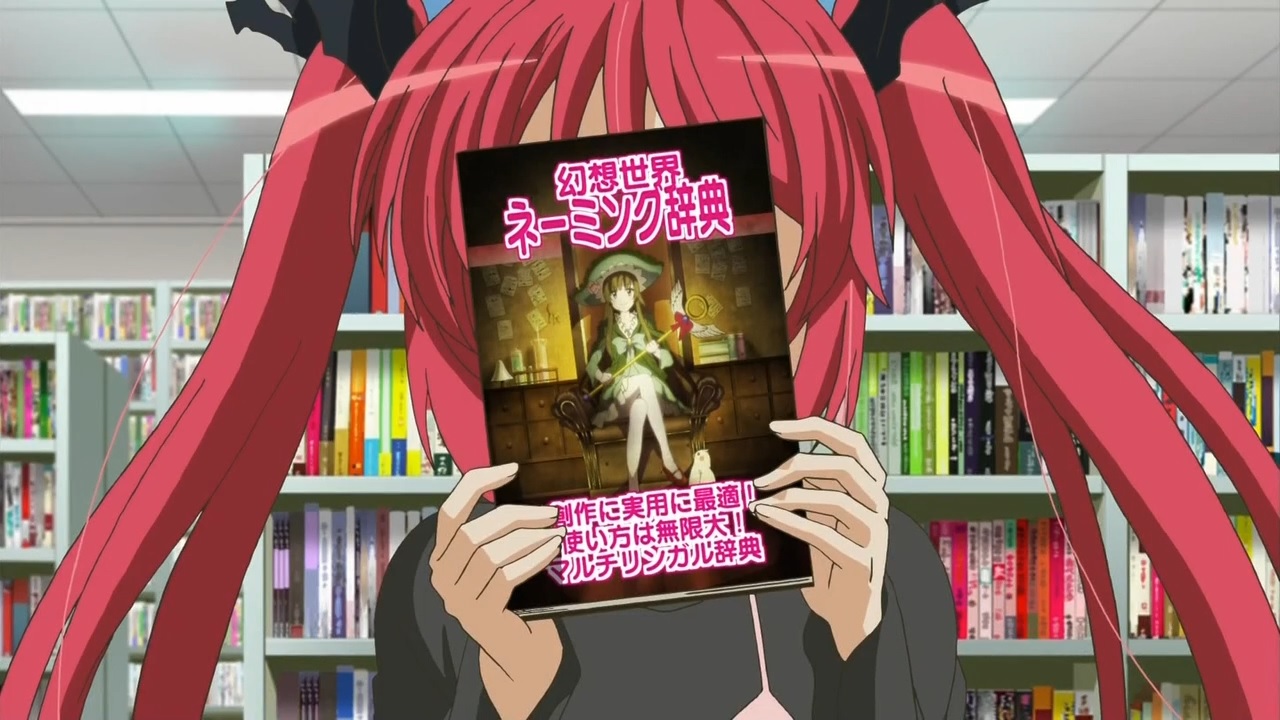
(8:53)
This is the book that Cthuko is holding.
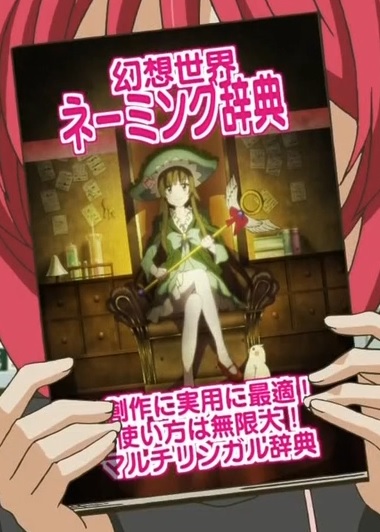
The title of the book is "Gensou Sekai Neemingu Jiten" (幻想世界ネーミング事典), which translates to "Fantasy World Naming Encyclopedia". The title and appearance of this book are referencing those of "Gensou Sekai Juuikkakokugo Neemingu Jiten" (幻想世界11カ国語ネーミング辞典), "Fantasy World 11 Languages Naming Dictionary", a book released in 2011 that contains 13409 words in 11 different languages to be used for creating names.S2 Image for reference:
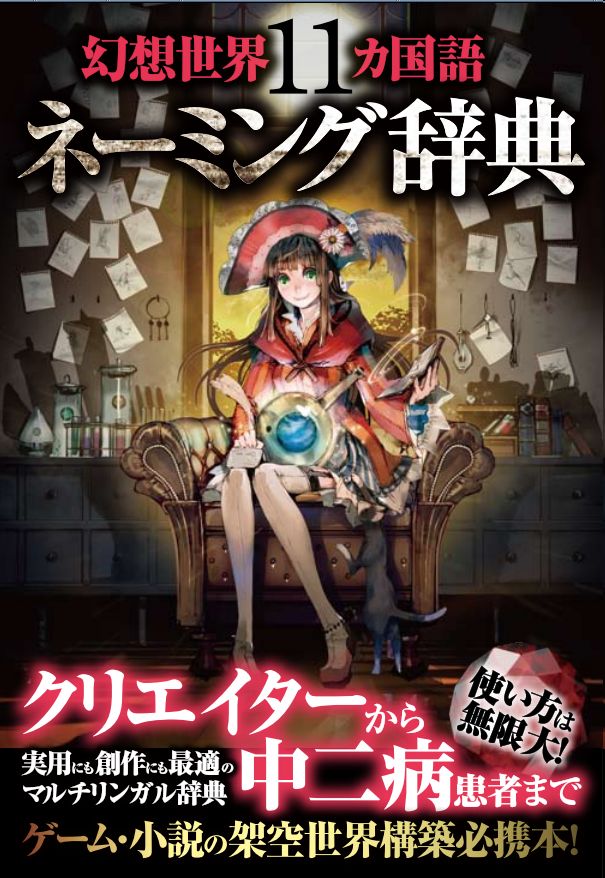
Source of image: http://www.telescope-ltd.jp/works.htm
The artist who illustrated the art for the cover of the book, Tsukasa Kiryu (輝竜司), also uploaded the original illustration on pixiv.
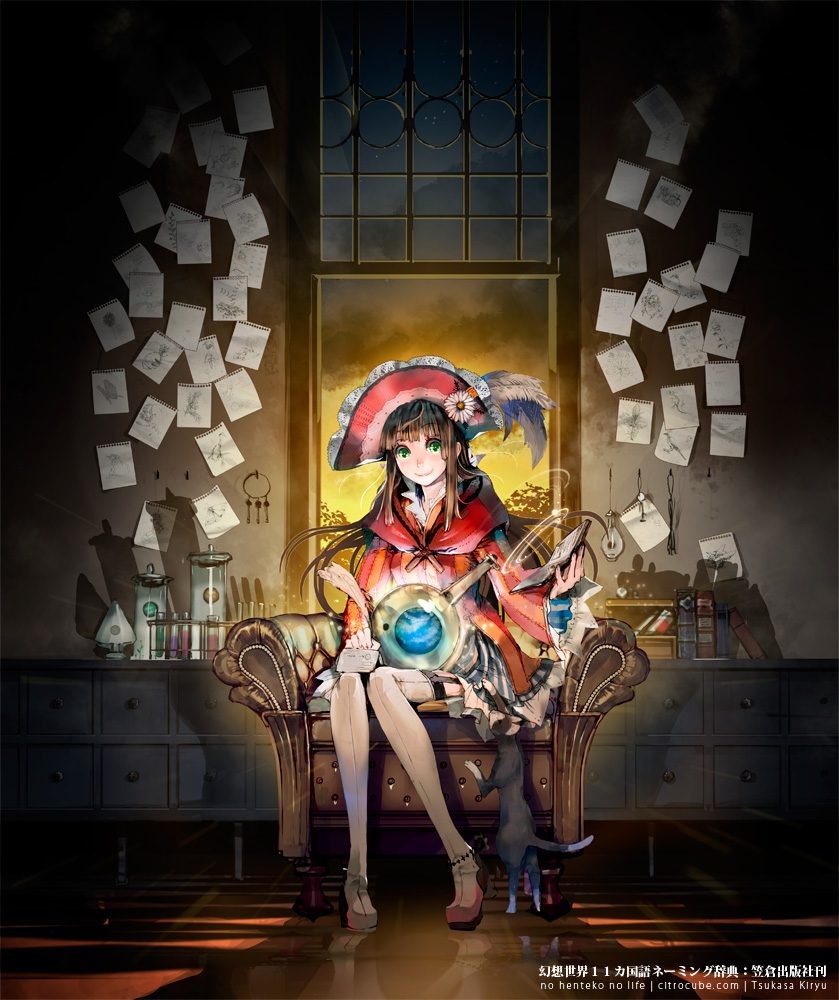
Source of image: https://www.pixiv.net/artworks/19182375

"Well then, if we insert Mahiro into Kuuko, Kuroko..." (9:09)
When Cthuko says "Kuroko", immediately Shanta-kun shouts out. This is referencing Shirai Kuroko (白井黒子) from "To Aru Majutsu no Indekkusu" (とある魔術の禁書目録), "A Certain Magical Index", a light novel series written by Kamachi Kazuma (鎌池和馬) and published from 2004 and is currently ongoing. In the anime adaptation of this series, Kuroko is voiced by Arai Satomi (新井里美), who also voices Shanta-kun.
"If it's a boy, we'll make him play basketball. If it's a girl, we'll enroll her in Academy City." (9:19)
This is a follow up to the name "Kuroko". There are two references here:
* Basketball is referencing "Kuroko no Basuke" (黒子のバスケ), "Kuroko's Basketball", a manga series written by Fujimaki Tadatoshi (藤巻忠俊) and published from 2009 and is currently ongoing.S1 The main character of the series is named Kuroko Tetsuya (黒子テツヤ).
* "Gakuen Toshi" (学園都市), "Academy City", is the primary setting of "To Aru Majutsu no Indekkusu" (とある魔術の禁書目録), "A Certain Magical Index". In the series, Shirai Kuroko (白井黒子) attends Tokiwadai Middle School (常盤台中学), which is located within Academic City.
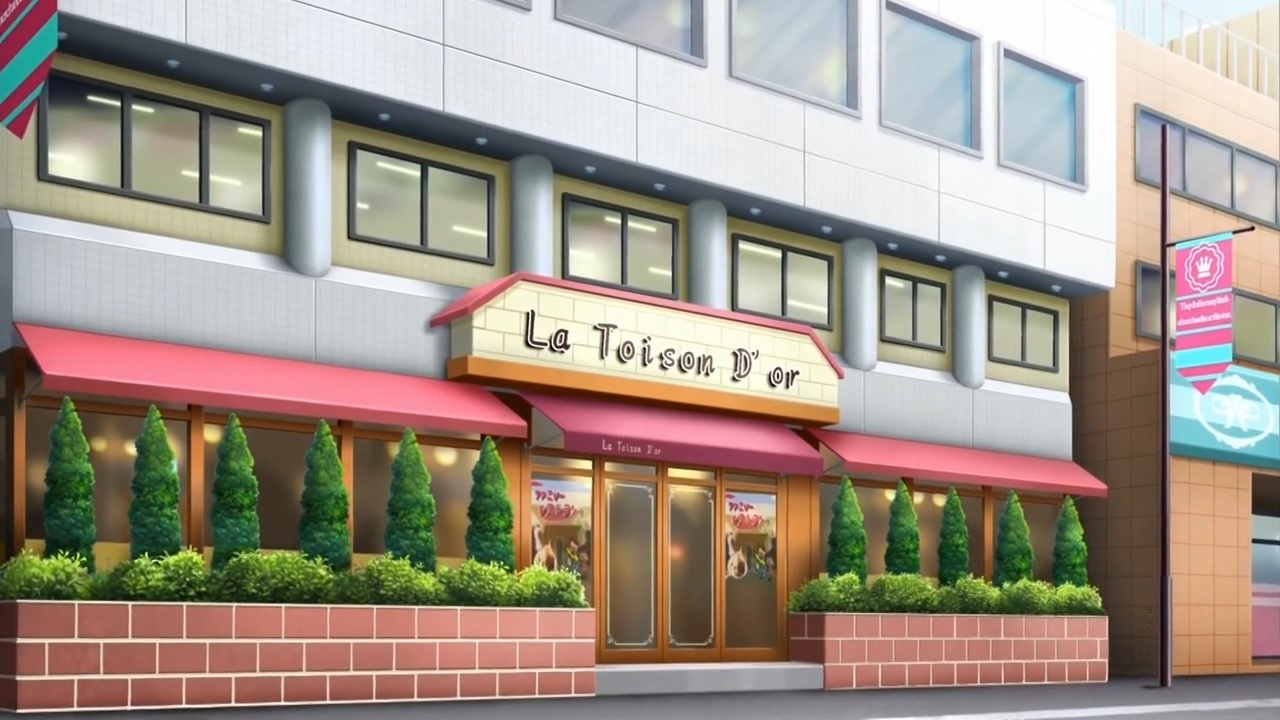
(9:58)
This is the sign for the restaurant.

The name of the restaurant is "La Toison D'or", which is French for "The Golden Fleece". In Japanese the name translates to "Kinyoumou" (金羊毛). This is referencing "Mikan Shoujo Ravukurafuto" (未完少女ラヴクラフト), "Unfinished Girl Lovecraft", a light novel written by Kuro Shirou (黒史郎) and published in 2013. One of the main characters, Kanna Serio (カンナ・セリオ), works at a place called 「金羊毛」, which is indicated in the text to be read as "Towazon Dooru" (トワゾン・ドール), "Toison D'or".S3 Image for reference:

Source of image: http://d.hatena.ne.jp/servitors/20130515/p1
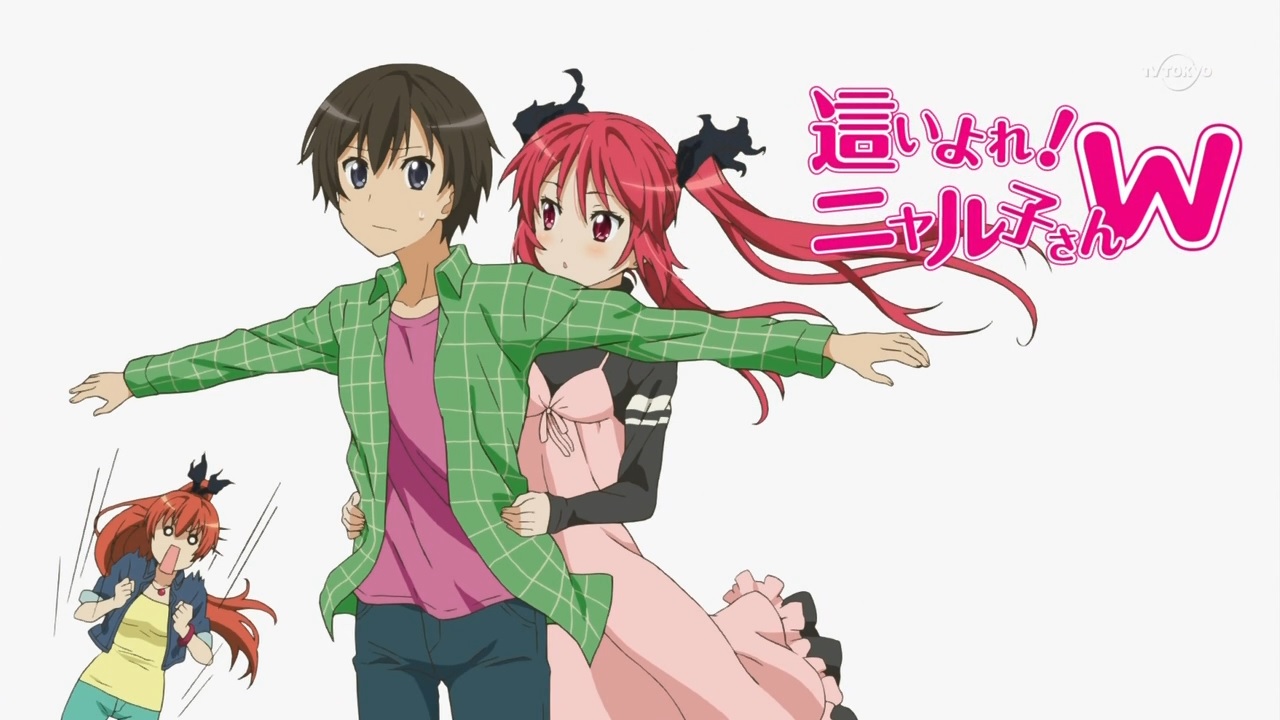
(10:30)
Mahiro and Cthuko's poses are referencing those of Rose and Jack respectively from a scene in "Titanic", an American movie released in 1997. In addition, Cthuko says, "Doudai, Mahiroozu?" (どうだい、まひローズ?), which translates to "How is it, Mahi-Rose?". This is another reference to Rose, whose pose Mahiro is mimicking.
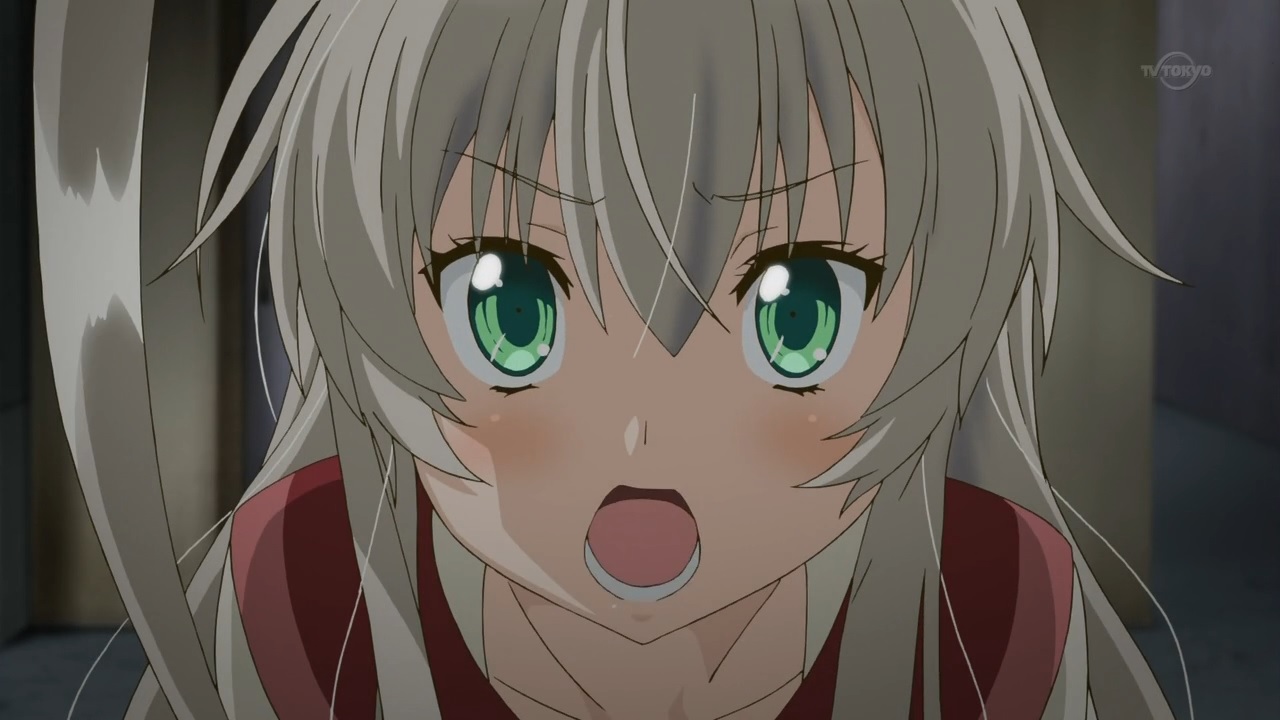
"Who are you going to kiss? Is it me?! Or is it me?! (11:18)
The Japanese line is "Mahiro-san ha dare to kisu suru n desu ka? Watashi desu ka?! Sore tomo watashi desu ka?!" (真尋さんは誰とキスするんですか?わたしですか?!それともわたしですか?!). This is referencing a line in the lyrics to "Toraianguraa" (トライアングラー), "Triangular", a song sung by Sakamoto Maaya (坂本真綾) and released in 2008.S1 This song is the first opening theme song for "Macross Frontier" (マクロスF), an anime series that aired in 2008. The line goes, "Kimi ha dare to kisu wo suru, watashi sore tomo ano ko" (君は誰とキスをする わたしそれともあの娘), which translates to "Who are you going to kiss? Is it me? Or is it that other girl?". In addition, there is an alternate version of this song called "Toraianguraa (fight on stage)" (トライアングラー(fight on stage)), "Triangular (fight on stage)". This alternate version is the ending theme song of episode 25 of the series, and it is sung by May'n and Nakajima Megumi (中島愛) and was released in 2008. In this version, the above mentioned line is changed to "Kimi ha dare to kisu wo suru, watashi sore tomo watashi" (君は誰とキスをする わたしそれともわたし), which translates to "Who are you going to kiss? Is it me? Or is it me?".
"The most powerful thing beneath this universe is only my love!" (11:27)
The Japanese line is "Kono uchuu no shita de saikyou na no ha watashi no omoi nomi nan desu yo!" (この宇宙の下で最強なのは私の思いのみなんですよ!). This is referencing a line in the lyrics to "LORD OF THE SPEED", a song sung by RIDER CHIPS featuring Satou Yuuki (佐藤祐基) and released in 2006. This song is a theme song used in "Kamen Rider Kabuto" (仮面ライダーカブト), a Japanese TV show about a masked super hero that aired from 2006 to 2007.S2 The original line goes, "Kono sora no shita de saikyou na no ha That's my pride jibun nomi" (この空の下で最強なのは That's my pride 自分のみ), which translates to "The most powerful thing beneath this sky, That's my pride, only myself".
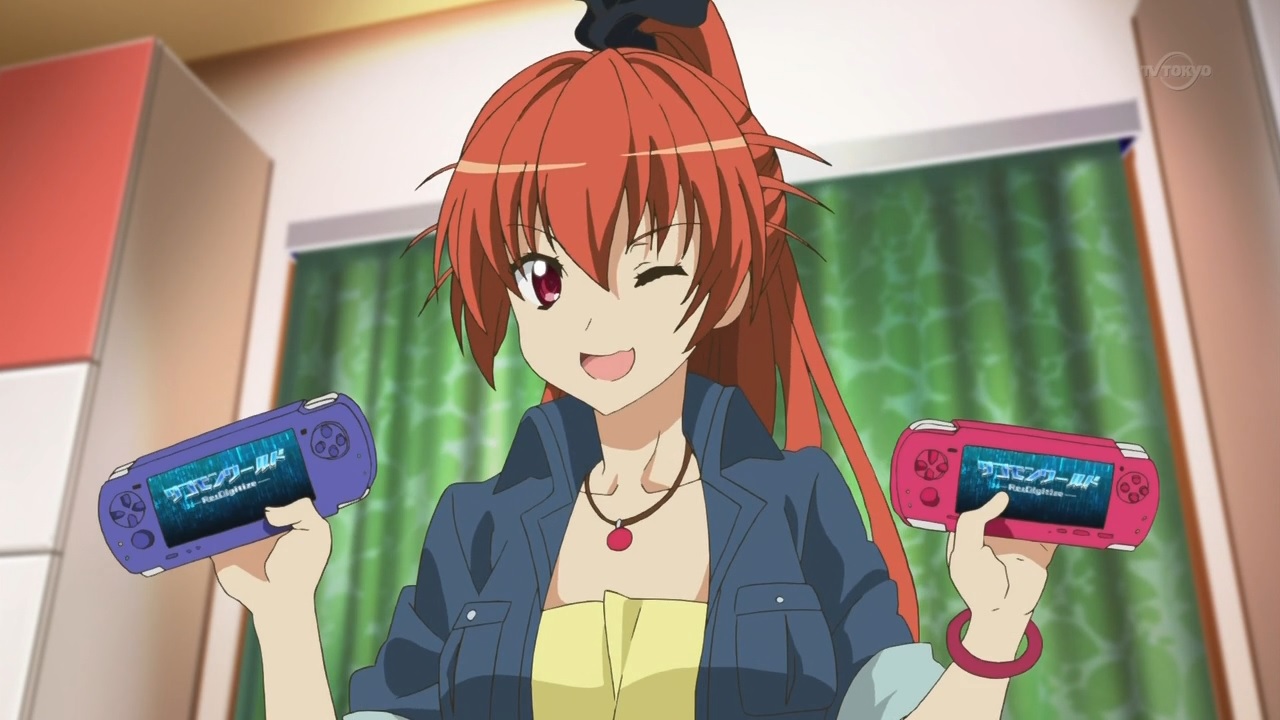
(13:40)
There are three references here:
* The game devices that Cthune is holding up are based on the PlayStation Portable (プレイステーション・ポータブル), a handheld video game console released by Sony (ソニー) in 2004. Image for reference:

Source of image: https://en.wikipedia.org/wiki/File:Sony-PSP-1000-Body.png
* This is the game shown on the screens of the devices.

The game is "Dagomon Waarudo -Re:Digitize-" (ダゴモンワールド-Re:Digitize-), "Dagomon World -Re:Digitize-". This is referencing "DIGIMON WORLD Re:Digitize" (デジモンワールド リ:デジタイズ), a game released for the PlayStation Portable in 2012.S1
* Dagomon (ダゴモン) is the name of a creature that appears in "Digimon Adventure 02" (デジモンアドベンチャー02), an anime series that aired from 2000 to 2001. On a related note, Dagomon itself is based on the Cthulhu Mythos. It first appears in episode 13 of "Digimon Adventure 02", and the title of this episode is "Dagomon no Yobigoe" (ダゴモンの呼び声), which translates to "The Call of Dagomon". This is referencing "Kuturufu no Yobigoe" (クトゥルフの呼び声), "The Call of Cthulhu", a short story written by H. P. Lovecraft and first published in 1928. Also, the appearance of Dagomon in the series is based on Cthulhu, and its name is based on Dagon, a sea dwelling creature and a servant of Cthulhu.
"And so, tonight we're going to play the new Dagomon live until morning!" (14:41)
Cthune says the phrase "asa made nama purei" (朝まで生プレイ), which translates to "live play until morning". This is referencing "Asa Made Nama Terebi" (朝まで生テレビ), "Live Television Until Morning", a Japanese late night television program.S2
(14:53)
The line at this time goes as follows:
「膝を抱える為の両手じゃありませんのに・・・お互いのハートを載せる為ですのに」This is referencing lines in the lyrics to "City Hunter ~Ai yo Kienaide~" (City Hunter~愛よ消えないで~), "City Huner ~O Love, Don't Disappear~", a song sung by Kohiruimaki Kahoru (小比類巻かほる) and released in 1987.S2 This song is the first opening theme song for "CITY HUNTER" (シティーハンター), an anime series that aired from 1987 to 1988. The original lines go as follows:
"Hiza wo kakaeru tame no ryoute ja arimasen no ni... Otagai no haato wo noseru tame desu no ni"
"Even though these hands aren't for holding my knees... Even though they're for carrying our hearts"
「膝をかかえるための」「昨日までの両手」
「今日からはおたがいの」「ハートをのせて」
"Hiza wo kakaeru tame no" "kinou made no ryoute"
"kyou kara ha otagai no" "haato wo nosete"
"The hands that until yesterday were for holding my knees"
"from today onwards are for carrying our hearts"
(15:20 - 17:09)
Nyaruko's lines during this scene are referencing a scene from "Wind -a breath of heart-" (ウインド ア ブレス オブ ハート), a visual novel released in 2002.S1 In the scene, the main heroine, Narukaze Minamo (鳴風みなも), confronts the main character and demands to know what he thinks of her.
"That heat woman" (16:53)
The Japanese line is "Ano hiito no onna" (あのヒートの女). This appears to be referencing "Kamen Raidaa W FOREVER A to Z / Unmei no Gaia Memori" (仮面ライダーW FOREVER AtoZ/運命のガイアメモリ), "Kamen Rider W FOREVER A to Z / The Gaia Memories of Fate", a movie released in 2010.S1 In the movie, one of the main characters, Hidari Shoutarou (左翔太郎), refers to one of the antagonists, Hanehara Reika (羽原レイカ), as "Ano hiito no onna" (あのヒートの女), which translates to "That Heat woman".
"Are you saying it's a sin to love you-topia?" (17:34)
The Japanese line is "ai suru koto ga tsumi da to yuutopia?" (愛することが罪だとユートピア?). The term "yuutopia" (ユートピア) means "utopia", and in this line it is used as a pun on "yu" (言う), which means "to say" in Japanese. The line as a whole is referencing a line said by Kazu Jun (加頭順) in episode 48 of "Kamen Rider W" (仮面ライダーW), a Japanese TV show about a masked super hero that aired from 2009 to 2010.S2 In the series, Kamen Rider W's catch phrase is "Saa, omae no tsumi wo kazoero!" (さあ、お前の罪を数えろ!), which translates to "Now, count up your sins!". In response to this, Jun says, "Hito wo ai suru koto ga... tsumi da to demo..." (人を愛することが・・・罪だとでも・・・), which translates to "Even if loving someone... is a sin...". After saying this line, Jun activates his UTOPIA Gaia Memory which announces "Utopia" (ユートピア).
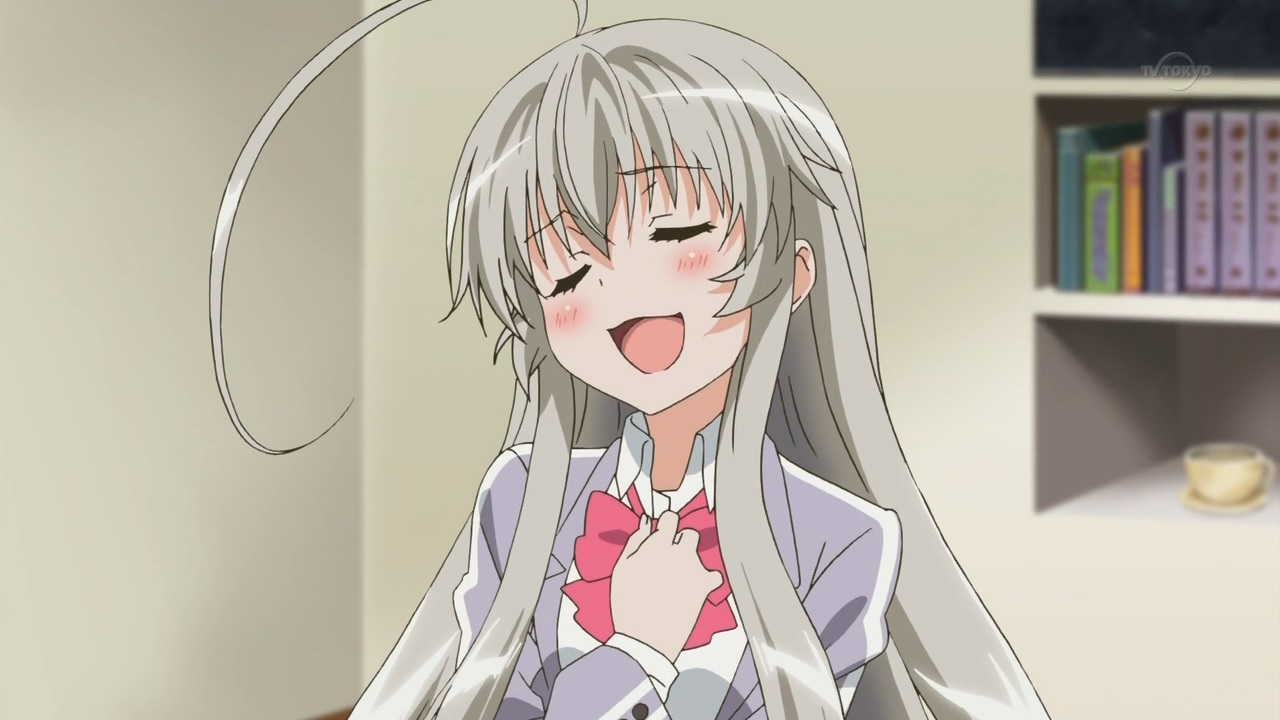
"I am the beast that shouts love at the heart of space!" (20:59)
The Japanese line is "Watashi ha uchuu no chuushin de ai wo sakebu kedamono desu!" (私は宇宙の中心で愛を叫ぶけだものです!). There are two references here:
* This is referencing "The Beast that Shouted Love at the Heart of the World", a short story written by Harlan Ellison and published in 1968.S1 The Japanese translation of the title is "Sekai no Chuushin de Ai wo Sakenda Kemono" (世界の中心で愛を叫んだけもの).
* This is referencing "Neon Genesis Evangelion" (新世紀エヴァンゲリオン), an anime series that aired from 1995 to 1996.S1 The title of episode 26 of the series is "Sekai no Chuushin de Ai wo Sakenda Kemono" (世界の中心でアイを叫んだけもの), which translates to "The Beast that Shouted 'I' at the Heart of the World".
"Ari ari ari arrivederci!" (21:56)
The Japanese line is "Ari ari ari ariivederuchi!" (アリアリアリアリーヴェデルチ!). "Arrivederci" means "goodbye" in Italian. This is referencing the same line said by Bruno Buccellati (ブローノ・ブチャラティ) in chapter 499 in volume 53 of "Jojo no Kimyou na Bouken" (ジョジョの奇妙な冒険), "Jojo's Bizarre Adventure", a manga series written by Araki Hirohiko (荒木飛呂彦) and published starting from 1987.S1 Images for reference:
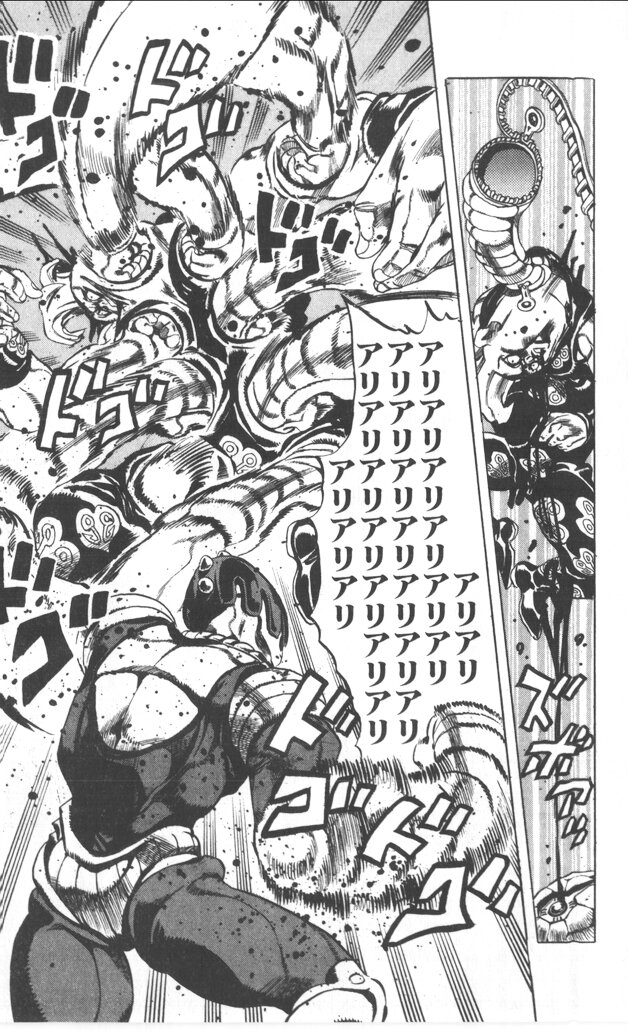
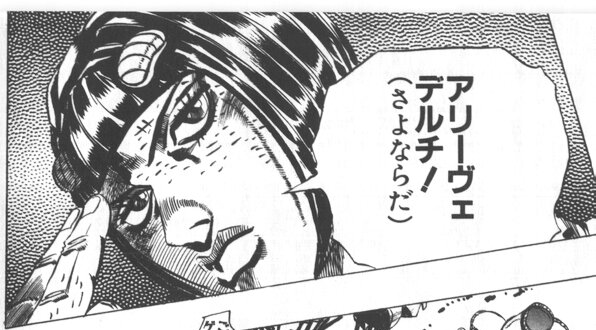
"Please take responsibility!" (24:22)
The Japanese line is "Sekinin totte kudasai ne!" (責任とって下さいね!). This appears to be referencing a line said by Lum (ラム) in "Urusei Yatsura 2: Beautiful Dreamer" (うる星やつら2 ビューティフル・ドリーマー), a movie that was released in 1984.S2 Lum's original line is "Sekinin totte ne!" (責任とってね), which has the same meaning as above.
List of Sources:
S1. Comments on this post
S2. A post at Steman Blog (ステマブログ)
S3. A blog by servitors about Cthulhu Mythos inspired works (クトゥルー/クトゥルフ神話作品発掘記)
Thanks to everyone who contributed! This list wouldn't be nearly as long without you all. See you next episode!
情報を教えてくださって本当にありがとうございました!皆さんがいなかったら、このリストはぜんぜん長くありません。またこの次までね!
Last updated February 22, 2022
Sitemap
Home
